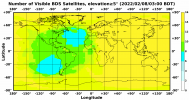Ripped right from the FCC - "The Federal Communications Commission (FCC) rules require licensing of non-federal receive-only equipment operating with foreign satellite systems, including receive-only earth stations operating with non-U.S. licensed radionavigation-satellite service (RNSS) satellites."All GPS satellite systems are open access.
There is no licensing.
There is a waiver process to waive this requirement; on November 15, 2018, the European Union received the first waiver of the FCC's licensing requirements under the process described above.












